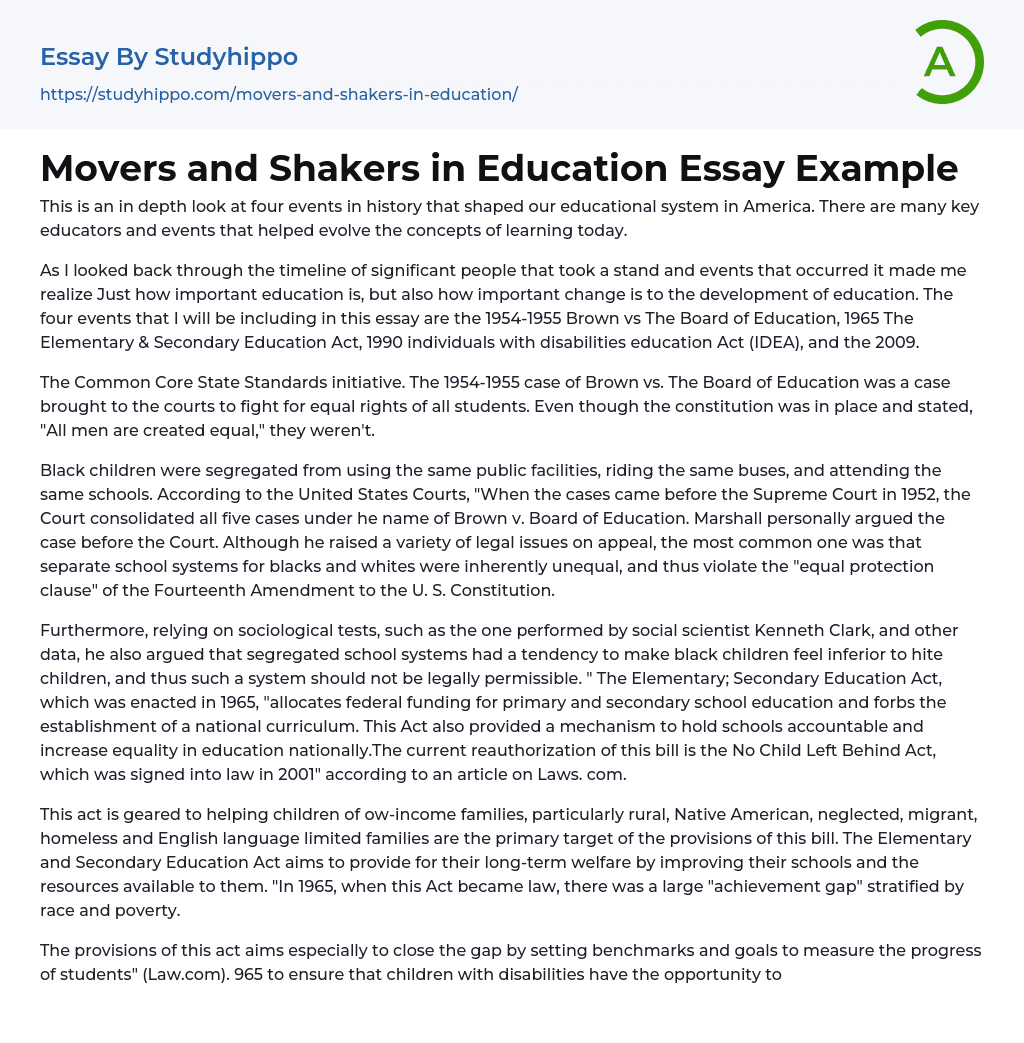This is an in depth look at four events in history that shaped our educational system in America. There are many key educators and events that helped evolve the concepts of learning today.
As I looked back through the timeline of significant people that took a stand and events that occurred it made me realize Just how important education is, but also how important change is to the development of education. The four events that I will be including in this essay are the 1954-1955 Brown vs The Board of Education, 1965 The Elementary & Secondary Education Act, 1990 individuals with disabilities education Act (IDEA), and the 2009.
The Common Core State Standards initiative. The 1954-1955 case of Brown vs. The Board of Education was a case brought to the courts to fight for equal rights of all students. Even though the constitution
...was in place and stated, "All men are created equal," they weren't.
Black children were segregated from using the same public facilities, riding the same buses, and attending the same schools. According to the United States Courts, "When the cases came before the Supreme Court in 1952, the Court consolidated all five cases under he name of Brown v. Board of Education. Marshall personally argued the case before the Court. Although he raised a variety of legal issues on appeal, the most common one was that separate school systems for blacks and whites were inherently unequal, and thus violate the "equal protection clause" of the Fourteenth Amendment to the U. S. Constitution.
Furthermore, relying on sociological tests, such as the one performed by social scientist Kenneth Clark, and other data, he also argued that segregated schoo
systems had a tendency to make black children feel inferior to hite children, and thus such a system should not be legally permissible. " The Elementary; Secondary Education Act, which was enacted in 1965, "allocates federal funding for primary and secondary school education and forbs the establishment of a national curriculum. This Act also provided a mechanism to hold schools accountable and increase equality in education nationally.The current reauthorization of this bill is the No Child Left Behind Act, which was signed into law in 2001" according to an article on Laws. com.
This act is geared to helping children of ow-income families, particularly rural, Native American, neglected, migrant, homeless and English language limited families are the primary target of the provisions of this bill. The Elementary and Secondary Education Act aims to provide for their long-term welfare by improving their schools and the resources available to them. "In 1965, when this Act became law, there was a large "achievement gap" stratified by race and poverty.
The provisions of this act aims especially to close the gap by setting benchmarks and goals to measure the progress of students" (Law.com). 965 to ensure that children with disabilities have the opportunity to receive a free appropriate public education, Just like other children. This law has been revised many times over the years to the most recent amendments were passed by Congress in December 2004, with final regulations published in August 2006 (Part B for school- aged children) and in September 2011 (Part C, for babies and toddlers).
The mission statement on the Common Core State Standards Initiative website states, "The Common Core State Standards provide a consistent, clear understanding f
what students are expected to learn, so teachers and parents know what they need to do to help them. The standards are designed to be robust and relevant to the real world, reflecting the knowledge and skills that our young people need for success in college and careers.
With American students fully prepared for the future, our communities will be best positioned to compete successfully in the global economy'.
References
- http://www.uscourts.gov/educational-resources/educational-activities/history-brown-v-board-education-re-enactment
- Academia essays
- Higher Education essays
- Language Learning essays
- Studying Business essays
- Education System essays
- Study essays
- First Day of School essays
- Scholarship essays
- Pedagogy essays
- Curriculum essays
- Coursework essays
- Studying Abroad essays
- Philosophy of Education essays
- Purpose of Education essays
- Brainstorming essays
- Educational Goals essays
- Importance Of College Education essays
- Brown V Board of Education essays
- The Importance Of Higher Education essays
- Online Education Vs Traditional Education essays
- Academic And Career Goals essays
- Academic Integrity essays
- Brown Vs Board Of Education essays
- Distance learning essays
- Technology in Education essays
- Vocabulary essays
- Writing Experience essays
- Importance of Education essays
- Early Childhood Education essays
- Academic Degree essays
- Academic Dishonesty essays
- School Uniform essays
- Academic writing essays
- Cheating essays
- Bachelor's Degree essays
- MBA essays
- College Life essays
- Grade essays
- Diploma essays
- Phonology essays
- Sentence essays
- Filipino Language essays
- Pragmatics essays
- Millennium Development Goals essays
- History Of Education essays
- Graduate School essays
- Middle School essays
- School essays
- Special Education essays
- University essays




